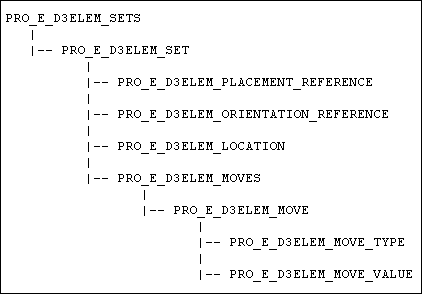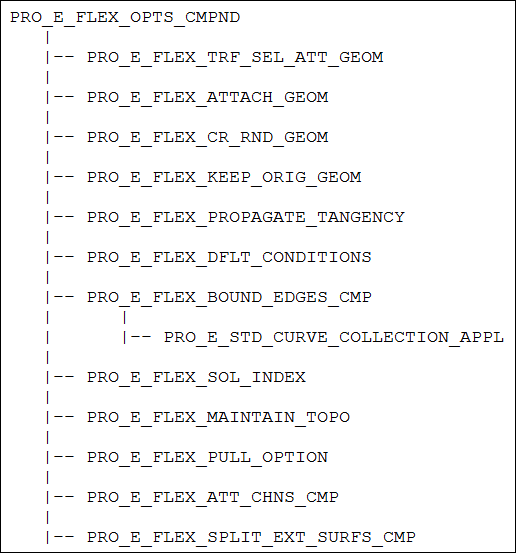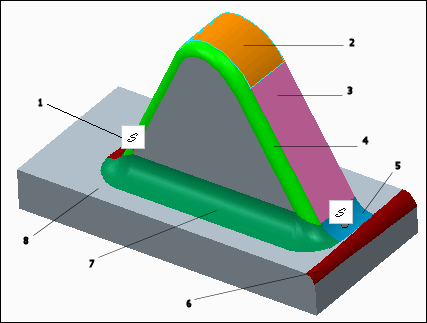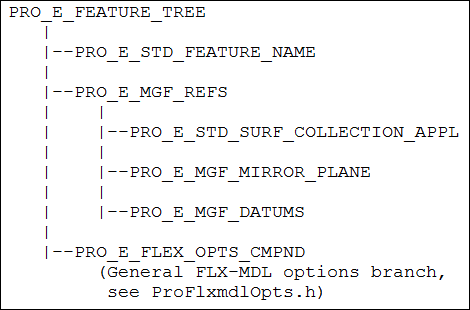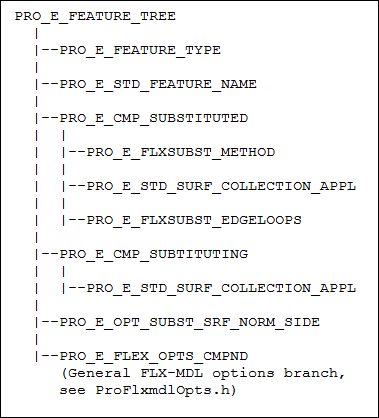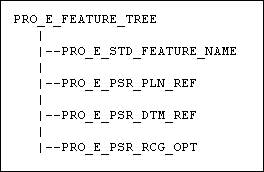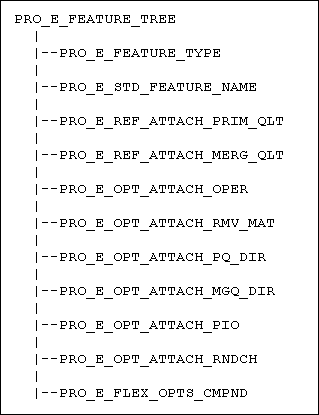Move and Move-Copy Features
This section describes how to construct and access the element tree for Move and Move-Copy features. It also shows how to
create, redefine, and access the properties of these features.
Introduction
The Move and the Move-Copy features allow a rigid transformation to a geometry selection or its copy. The surfaces within
the geometry selection must belong either to the solid geometry or to a single quilt. You can move the following the geometry
selection:
| • | Any surface collection within the solid geometry or a single quilt. |
| • | An intent surface within the solid geometry or a single quilt. |
| • | Regular or intent datums (planes, axes, points and coordinate systems). |
| • | Regular or intent curves. |
| • | Any combination of the above geometries. |
When you create a move feature at assembly level, the following types of references can be moved:
| • | Geometry of assembly components—Part level geometry only, that is, surfaces, quilts, curves, datums |
| • | Assembly components—Parts and subassemblies |
The moved entities are copies of the original entities and will have new IDs. The original entities can be removed (Move)
or kept (Copy-Move).
A Move feature will act on a single set of objects. To move different geometry selections, multiple move features must be
created.
The Element Tree for Move and Move-Copy
The element tree for the Move and Move-Copy feature is documented in the header file ProFlexMove.h, and is shown in the following figure:
Element Tree for Move and Move-Copy
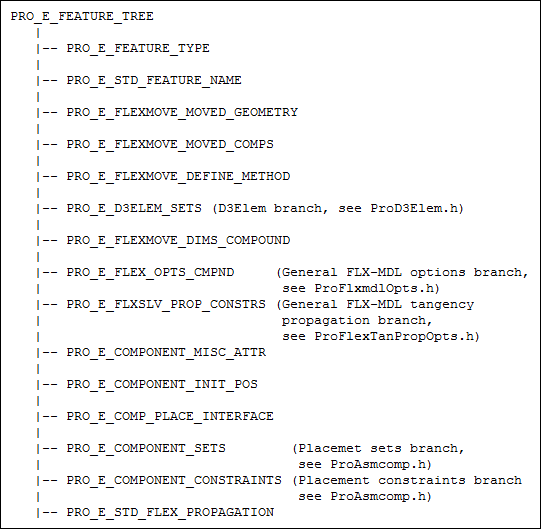
The following table describes the elements in the element tree for the Move and Move-Copy features:
|
Element ID
|
Data Type
|
Description
|
|||||||||
|---|---|---|---|---|---|---|---|---|---|---|---|
|
PRO_E_FEATURE_TYPE
|
PRO_VALUE_TYPE_INT
|
Specifies the type of feature.
|
|||||||||
|
PRO_E_STD_FEATURE_NAME
|
PRO_VALUE_TYPE_WSTRING
|
Specifies the name of the feature. The default value is Flex_Move.
|
|||||||||
|
PRO_E_FLEXMOVE_MOVED_GEOMETRY
|
Compound
|
Specifics the geometry to be moved.
|
|||||||||
|
PRO_E_FLEXMOVE_MOVED_COMPS
|
PRO_ELEM_TYPE_MULTI_VALUE
Note
The data type PRO_ELEM_ TYPE_MULTI_VALUE enables you to assign multiple values to the element, though the data type is not an array.
|
Optional element. This element is available only when you create the move feature at the assembly level. Specifies the collection
of component references, that is, parts and subassemblies in an assembly, which are moved by the assembly level move feature.
|
|||||||||
|
PRO_E_FLEXMOVE_DEFINE_METHOD
|
PRO_VALUE_TYPE_INT
|
Mandatory element. Specifies the method to be used to move the entities. It takes the following values:
|
|||||||||
|
PRO_E_D3ELEM_SETS
|
Array holder
|
Mandatory element when the definition method is PRO_FLEXMOVE_DEF_METHOD_3D_DRAG. An array holder of PRO_E_D3ELEM_SET elements.. The elements for 3D transformation sets are defined in ProD3Elem.h.
For more information, see the section 3D Transformation Set Feature.
|
|||||||||
|
PRO_E_FLEXMOVE_DIMS_COMPOUND
|
Compound
|
Mandatory element when the definition method is PRO_FLEXMOVE_DEF_METHOD_DIMENSIONS. Specifies the dimension references and arrays for the dimension definition method.
|
|||||||||
|
PRO_E_FLEX_OPTS_CMPND
|
Compound
|
Mandatory element that contains the flexible modeling geometry attachment options to attach the moved surfaces. Specifies
the integer and chain collection type elements. The elements related to reattachment of geometry in flexible modeling are
defined in ProFlxmdlOpts.h.
For more information, see the section Attachment Geometry Feature.
|
|||||||||
|
PRO_E_FLXSLV_PROP_CONSTRS
|
Array
|
Optional element. Specifies an array that contains the tangency conditions and the reference geometry elements for tangency
propagation.
The elements related to propagation of tangency in flexible modeling are defined in ProFlexTanPropOpts.h. For more information, see the section Tangency Propagation.
|
|||||||||
|
PRO_E_COMPONENT_SETS
|
Array holder
|
Mandatory element when the definition method is PRO_FLEXMOVE_DEF_METHOD_CONSTRAINTS. Specifies the constraint sets. The elements for constraint sets are defined in ProAsmcomp.h. For more information, see the section Constraint Sets and Mechanism Connections of section Assembly: Assembling Components.
|
|||||||||
|
PRO_E_COMPONENT_CONSTRAINTS
|
Array holder
|
Mandatory element when the definition method is PRO_FLEXMOVE_DEF_METHOD_CONSTRAINTS. Specifies the constraints. The elements for constraints are defined in ProAsmcomp.h. For more information, see the section Placement Constraints of section Assembly: Assembling Components.
|
|||||||||
|
PRO_E_STD_FLEX_PROPAGATION
|
PRO_VALUE_TYPE_SELECTION
|
Optional element. Specifies a pattern or mirror recognition feature to propagate the move feature changes.
|
Moved Geometry
The feature PRO_E_FLEXMOVE_MOVED_GEOMETRY is a compound element that allows you to select the geometries to be moved and the geometries to be excluded.
PRO_E_FLEXMOVE_MOVED_GEOMETRY
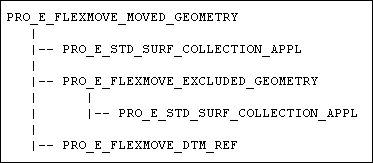
The following table lists the contents of PRO_E_FLEXMOVE_MOVED_GEOMETRY element.
|
Element ID
|
Data Type
|
Description
|
|---|---|---|
|
PRO_E_STD_SURF_COLLECTION_APPL
|
PRO_VALUE_TYPE_SELECTION
|
Mandatory element. Specifies the collection of surface sets of the geometries to be moved. It may also include surface regions.
|
|
PRO_E_FLEXMOVE_EXCLUDED_GEOMETRY
|
Compound
|
Optional element to exclude surfaces.
|
|
PRO_E_STD_SURF_COLLECTION_APPL
|
PRO_VALUE_TYPE_SELECTION
|
Optional element. Specifies the collection of surfaces from the move surfaces collector which should be excluded from the
move operation.
|
|
PRO_E_FLEXMOVE_DTM_REF
|
PRO_ELEM_TYPE_MULTI_VALUE
Note
The data type PRO_ELEM_TYPE_MULTI_VALUE allows you to assign multiple values to the element, though the data type is not an array.
|
Optional element. Specifies the collection of datum entities that should be moved with the moved geometry.
|
Dimension Elements
The element PRO_E_FLEXMOVE_DIMS_COMPOUND is a compound element that allows you to specify the dimensions to move the geometries.
PRO_E_FLEXMOVE_DIMS_COMPOUND
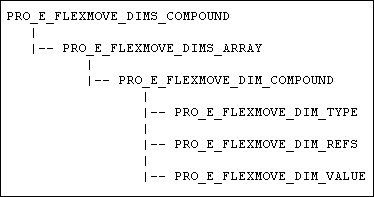
The following table lists the contents of PRO_E_FLEXMOVE_DIMS_COMPOUND element. All the elements are mandatory for the PRO_FLEXMOVE_DEF_METHOD_DIMENSIONS definition method type.
|
Element ID
|
Data Type
|
Description
|
||||||||||||||||||||||||
|---|---|---|---|---|---|---|---|---|---|---|---|---|---|---|---|---|---|---|---|---|---|---|---|---|---|---|
|
PRO_E_FLEXMOVE_DIMS_ARRAY
|
Array holder
|
Mandatory element. The dimensions array can contain up to three dimensions of PRO_FLEXMOVE_ DIM_TYPE_LINEAR type or a single dimension of PRO_FLEXMOVE_ DIM_TYPE_ANGULAR type.
|
||||||||||||||||||||||||
|
PRO_E_FLEXMOVE_DIM_COMPOUND
|
Compound
|
Mandatory element. Specifies the constraining dimensions to move the geometries.
|
||||||||||||||||||||||||
|
PRO_E_FLEXMOVE_DIM_REFS
|
PRO_ELEM_TYPE_MULTI
_VALUE |
Mandatory element. Specifies two references for the given dimension. Out of the two selected references one must belong to
the moved geometry and the other must belong to the geometry that is not affected by the move operation.
The valid values for reference selections are as follows:
The valid combinations for reference selections are as follows:
|
||||||||||||||||||||||||
|
PRO_E_FLEXMOVE_DIM_VALUE
|
PRO_VALUE_TYPE_DOUBLE
|
Mandatory element. Specifies the value of the linear or angular dimension.
The valid values are as follows:
|
